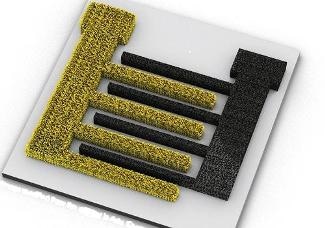Dec 6 2016
 Three-dimensional porous electrodes could lead to smaller and efficient integrated power sources. (CREDIT - Reproduced with permission from ref 1© John Wiley and Sons.)
Three-dimensional porous electrodes could lead to smaller and efficient integrated power sources. (CREDIT - Reproduced with permission from ref 1© John Wiley and Sons.)
Of late, energy storage units that can be incorporated into wearable and flexible electronic systems are gaining in importance. A research team from KAUST has recently developed a microsupercapacitor that exploits 3D porous electrodes. There is anticipation that these micropower units will enable a new generation of "smart"products, such as self-powered sensors for wearables, structural health monitoring, security, and internet of things applications.
However, for these units to be minuscule yet efficient, maximum energy density will have to go into the smallest area.
One method to achieve this is to build microbatteries using films with a thickness measuring just a few micrometers or less and to swap traditional electrolytes with solid-state electrolytes. Thin film batteries have shown comparatively high energy density, which is the amount of energy they can store in a specified area.
However, they are hindered by poor power density and limited cycle life, meaning they are not fast in charging and discharging.
Microsupercapacitors are a faster option, and they could prove ideal for applications requiring power pulsing and extended cycle life.
Also, while batteries must be charged at a constant voltage, a supercapacitor charges most efficiently by drawing the maximum current that the source can supply, irrespective of voltage.
KAUST Professor of Material Science and Engineering Husam Alshareef from the University's Functional Nanomaterials & Devices group
This makes supercapacitors a lot more appealing for use in self-powered system applications where the power source may be irregular.
Alshareef's team has recently created integrated microsupercapacitors with vertically-scaled 3D porous current collectors produced from nickel foams to optimize microsupercapacitor performance. The pores in the foam serve to increase the surface area.
This three-dimensional porous architecture allows excellent electrolyte permeability, good conductivity and faster ion transportation with maximum mass-loading of active material, which increase energy and power density in a given area.
KAUST Professor of Material Science and Engineering Husam Alshareef from the University's Functional Nanomaterials & Devices group.
Furthermore, the microsupercapacitors were asymmetric, using two different electrode materials for the anode (carbon nanofiber) and the cathode (nickel cobalt sulfide), which almost doubled the operating voltage. Consequently, while supplying high power density (4 mW/cm2), the microsupercapacitors had an energy density of 200 µW-hours / cm2.
This is higher than sophisticated microsupercapacitors, which achieve between 1 and 40 µW-hours / cm2, and is comparable to many types of thin film batteries. These high capacities were maintained even beyond 10,000 operating cycles.
The high energy and power density achieve in these devices may meet the demand of on-chip storage for various types of integrated microsystems.
KAUST Ph.D. student Qiu Jiang, the lead author of the study.